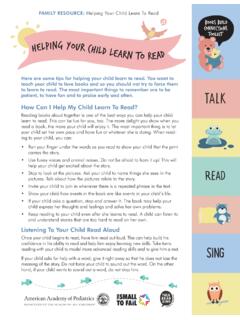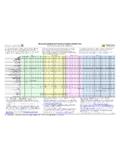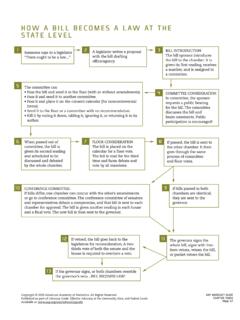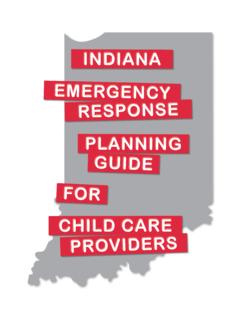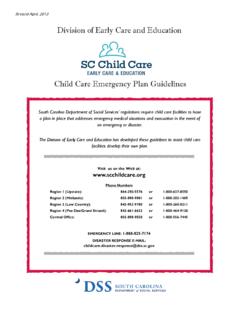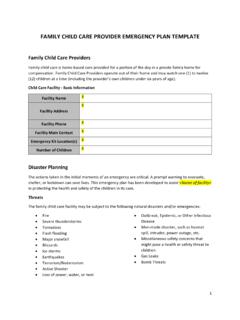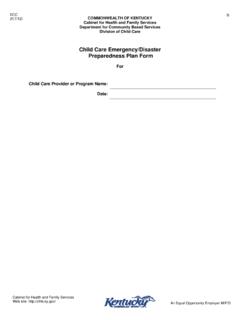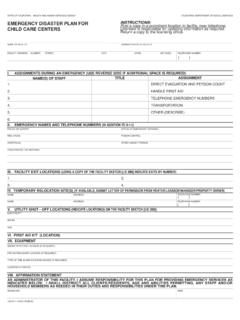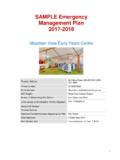Transcription of Child Care Emergency Planning - AAP.org
1 Every day. In times of crisis. For our Bradin, DO, FAAP and Andrew Hashikawa, MD, MS, FAAPN ovember 15, 2017 Child care Emergency PreparednessINTRODUCTIONS Dr. Stuart Bradin, DO Pediatrics and Pediatric Emergency Medicine Pediatric Lead Region 2 Healthcare Coalition Disaster Preparedness PEM Section of Emergency Medicine Disaster Preparedness Dr. Andrew Hashikawa Pediatrics and Pediatric Emergency Medicine Michigan Early Childhood Champion AAP Executive Committee, Council of Early Childhood Research on Disaster Preparedness Summer Camps and Child care Centers2 Agenda Part 1: Why Preparedness Matters in Child care Settings Part 2: Identifying Risks and Hazards Part 3: National Best Practices Part 4: Updating and Practicing the plan Question and Answer3 Learning Objectives Understand why children are at risk during disasters and emergencies.
2 Learn about essential components of Emergency preparedness Planning . Identify hazards and risks that could affect programs in your region. Understand best practices for disaster preparedness for Child care centers. Become familiar with national One: Why Preparedness MattersWhy is Emergency Planning so important for Child care settings? 5 Why Preparedness Matters6 Emergencies and disasters will happen You are on the frontlines Preparedness and training are ongoing processes Need for raising awareness and becoming a resourceYou may be asked as an expert of children!Gaps in Protecting Children7 Disasters can strike anywhere at any time. Each workday, 69 million children are in Child care or school, separated from their families. More than half of American families don t have an Emergency plan . FEMA 41% of parents report not knowing their Child s school or Child care evacuation location.
3 Save the Children 79% of recommendations made by the National Commission on Children in Disasters remain unfulfilled 10 years after Katrina. Save the Children Following Hurricane Katrina, there were more than 5,000 reports of missing children and it took 7 months to reunite the last Child with her family. National Commission on Children in Disasters Children affected by large disasters are five times as likely to have serious emotional issues than those who are unaffected. Children s Health Fund; Columbia UniversityProtecting the Most Vulnerable8 Children are not simply little adults. CHILDREN S UNIQUE NEEDS Reliance on Caregivers Communication & Identification Mobility Safety and Protection Physical Needs Nutritional Needs Emotional Needs Developmental Needs Routine and Comfort Most frequent disasters than any other nation Most different types of natural disasters High risk for shooter violence and manmade StatesYOUR STATE?
4 Disasters Happen10 Minimize RisksSafeguard businessProtect staff and volunteersProtect children Recover more quicklyConsiderations for Disaster Preparedness in Child CareNational Regulations11 Child care and Development Block Grant (CCDBG) Act of 2014 Statewide Child care Disaster plan Disaster Plans Components Requirements that Child care providers have in place evacuation, relocation, shelter-in-place, and lock-down procedures, and procedures for communication and reunification with families, continuity of operations, and accommodation of infants and toddlers, children with disabilities, and children with chronic medical conditions. Guidelinesfor the continuation of Child care services in the period following the Emergency or disaster, which may include the provision of Emergency and temporary Child care services, and temporary operating standards for Child care providers during that period.
5 Requirementsthat Child care providers have in place procedures for staff and volunteer Emergency preparedness training and practice Your State Licensing Requirements: 12 Emergency contact and release information Provision for Emergency medical care , treatment of illnesses and accidents Evacuation plan including procedures for notifying the parents of the relocation site Policy and procedures for handling dangerous situations, including violent crimes and bomb threatsDon t Go It Alone13It takes a whole community to protect children. Know your resources and supports. Emergency management Public Health Sheriff and Police Child care Resource and Referral First Responders Seek out Child care Centers Insurance Providers State Agencies School DistrictsAAP and SAEM contacts:Part Two: Identifying Risks and HazardsKnow your regional hazards and emergencies14 Assess the Risk Probability or frequency Likely effects Severity of impact Lead time for warning Potential duration Follow-on or cascading effects1617 Not Everyday RisksWhich hazards pose the greatest risk to the program?
6 18 NaturalTechnologicalBiologicalSafety/Man madeEarthquakeDam FailureContaminatedFood OutbreakActive ShooterFireGas LeakInfectious DiseaseBombThreatFloodHazardousMaterialT oxicMaterialsCriminal ActivityHurricaneIndustrial ExplosionCyber AttackLandslideNuclearPlant leakIntruderTornadoPowerOutageTsunamiWat er OutageWinter StormAssess the Risk Probability or frequency Likely effects Severity of impact Lead time for warning Potential duration Follow-on or cascading effects19 Sample Risk Assessment Worksheet Risk20 Severe Weather: Monitor the Threat Sign up for phone weather alerts Obtain an NOAA Weather Radio Use radio or television for dissemination Child care often NOT part of School District Encourage Networking among Centers (phone/social media)Top Weather Monitoring Apps NOAA Radio/ Weather American Red Cross Weather Channel Dark Sky Eg. A Disaster Was Not PredictedAtlanta Ice Storm January 2013 Icy conditions paralyzed traffic just as school was letting out.
7 More than 2,000 children spent the night at schools across the metro area. Some parents spent hours behind the wheel trying to get to their children. Frantic parents lashed out at schools, accusing them of poor Planning and communications. One MarrietaCounty mother wrote on the Schools Facebook page:21 I can't get to him since my car is stuck! I called for over 3 hours and couldn't get through due to busy lines and no one answering. I haven't spoken to my son and am worried sick!!!Utility Outage Tips Know how to use Emergency shutoffs including water, gas and electricity. Train staff how to turn off utilities and what to do in case of an outage. Use a landline telephone that does not use electricity. Have surge protectors. Consider purchasing a generator. Know utility providers and contact Shooter PerceptionsActive shooter incidents are much less frequent than other emergencies Americans are 38% more likely to be struck by lightning than an active shooter (FBI Study of Active Shooter Incidents).
8 Less than .0001% of deaths of school-age children a year happen on school grounds or on the way to and from school or during a school sponsored event. (CDC, Census). Examples of more deadly threats for children under 10: Motor-vehicle accidents, Drowning, Poisoning, are worried 70% of parentsare at least somewhat worried about a school/ Child care shooting affecting their children (Save the Children).24 Active Shooter Tips Practice lockdown procedures and evacuation routes Establish an internal communication system Create a trusting environment where families or staff can report potential conflicts that could escalate or abnormal behavior. Address response options: (KEEPING DEVELOPMENTAL AGE GROUPS IN MIND) DIFFERENT FROM SCHOOLS RUN HIDE FIGHT Teach staff to be aware of surroundings25 Part Three: National Best Practices Ensuring Child cares are prepared26 Nine Best a written current health and safety and implement family communication and reunification Emergency team and Emergency equipment and children and adults with all levels of your program information and plan and educate staff and families1.
9 Written PlanA written plan : Addresses the different needs of the children and staff Meets state and accreditation regulations Identifies a clear decision-maker in emergencies and informs everyone about their roles Sharedwith local Emergency response agencies, community partners, staff, volunteers, and parents/guardians Provides opportunity to discuss these issues with parents, staff, and children28 First Steps to Written plan Determine who should be involved in writing and reviewing the plan Consider size of program Document how many children are served in facility and contact information Gather first response agency information Create site plan map with shelter-in-place locations, exits, and outside evacuation sites Include letters of agreement with partnering organizations (for sheltering, evacuation) Workbook: Emergency plan Current Health & Safety Info Keeping up-to-date data in portable storage devices is vital in an Emergency : To quickly evacuate Emergency numbers after evacuating Access to medical information Access to Emergency contactphone numbers Emergency release informationand forms30 First Steps In Maintaining Info Gather current Emergency contact information for families and staff.
10 Obtain Emergency Releases for children for permission to transport. Enhance your Child -staff roster using electronic storage of information. Produce Child identification badges. Obtain permission to provide Emergency medical care to You Need Ready-to-GoHave printed copies ready! Emergency plan Emergency Release Forms Child -Staff Roster Child Identification Badges Sign-in/sign-out sheets Facility Incident/Injury Report Form Facility Medical Release FormPlace on Ready-to-Go file in portable container near Disaster Supplies Kit. Place another in an off-site (In Case of Emergency ) Contact Card3435 Produce Child Identification BadgesAddress/Phone NumberNameNameAddress/Phone NumberNameNameNameNamePhone Number/EmailPhone Number/EmailPhone Number/EmailPhone Number/Email3. Communicating with Families Auto-call, text and/or email 1-800 number/machine Local TV or radio Website Social Media Phone tree Texting Group Apps36Be sure to identify ways to communicate with parents who may not speak English or who may have visual or hearing impairmentsCommunication Messages What happened/is happening in general terms (type of hazard, response actions and status) If you know all children are accounted for If and when it is safe for guardians to pick-up Evacuation/Pick-up location Reunification Requirements ( , bring photo ID)DO NOT: Share information you re unsure about or make false promises ( , everyone is safe) Invite guardians to an unsafe environment37 Communication RealitiesPrepare for Outages.
